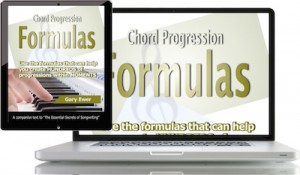If you like the sound of diminished chords but don’t know how to use them, read on.
 Get “The Essential Secrets of Songwriting” 10 e-book bundle. (with a free copy of “Creative Chord Progressions”): “Gary, I just wanted to say THANK YOU for helping the untrained musician learn to understand the fundamentals of music…”
Get “The Essential Secrets of Songwriting” 10 e-book bundle. (with a free copy of “Creative Chord Progressions”): “Gary, I just wanted to say THANK YOU for helping the untrained musician learn to understand the fundamentals of music…”
 Naturally-occuring diminished chords are ones that are built on the 7th note of a major scale. If your song is in the key of G major, the diminished chord that exists naturally for that scale is F#dim, using the notes F#-A-C. As you can see, a diminished chord is a stack of minor 3rds. Most of the time when a musician uses a diminished chord, they’re adding a diminished seventh on top, making a 4-note chord. Diminished seventh chords are beautiful when used correctly, but can sound out-of-place if they’re simply “thrown in.” So let’s look at how to work diminished seventh chords into a typical progression.
Naturally-occuring diminished chords are ones that are built on the 7th note of a major scale. If your song is in the key of G major, the diminished chord that exists naturally for that scale is F#dim, using the notes F#-A-C. As you can see, a diminished chord is a stack of minor 3rds. Most of the time when a musician uses a diminished chord, they’re adding a diminished seventh on top, making a 4-note chord. Diminished seventh chords are beautiful when used correctly, but can sound out-of-place if they’re simply “thrown in.” So let’s look at how to work diminished seventh chords into a typical progression.
The neat thing about a diminished seventh chord is that any of the notes within the chord can act as a kind of “leading tone.” That means that you can resolve any note of a diminished seventh chord upward by a semitone, and then play a major chord on the resulting note.
For example, if your song is in the key of G major, and you’re playing F#dim7 (F#-A-C-Eb), that chord sounds just fine if you follow it with any of the following chords: G (listen); Bb (listen); Db (listen); or E (listen). You can also resolve the diminished seventh chord to the minor versions of those chords as well.
 A single chord progression formula can give you many usable progressions to try, and you can come up with them in seconds. “Chord Progression Formulas” shows you how it’s done.
A single chord progression formula can give you many usable progressions to try, and you can come up with them in seconds. “Chord Progression Formulas” shows you how it’s done.
You’ll notice that only two of those resolution chords, G and Em, is actually in the key of G major. So most of the time, the naturally-occuring diminished chord on the 7th note of the scale works best if it moves to a naturally-occuring chord in your chosen key, or if your song is changing key.
There’s a better and more versatile way, however, to create and use diminished seventh chords, and it’s this: create a diminished seventh chord that’s built on the semitone below any chord you’re moving to.
For example, if your chord progression starts with: G Am, you can insert a diminished seventh chord that builds a stack of minor 3rds starting on G#: G G#dim7 Am (listen). That G#dim7 is made up of the four notes G#-B-D-F.
Continuing with this process, a diminished chord can be a nice connector that fits nicely between every naturally-occuring chord in G major. Doing this creates a rising semitone scale in the bass. So you can turn this sequence of chords: G Am Bm C D Em F#dim G into this:
G G#dim7 Am A#dim7 Bm C C#dim7 D D#dim7 Em Fdim7 F#dim G (listen)
You’ll hear that I didn’t insert a diminished seventh on Bm, as there is a semitone already between Bm and C, but there’s no particular reason that you couldn’t.
So if you feel stuck trying to figure out a way to use diminished chords in your chord progressions, try this basic rule: take any chord within your progression, and build a diminished 7th (a chord with stacked minor 3rds) on the note that’s a semitone below the chord you’ve chosen.
By doing that, you’ll turn this: G D Am D Em into this: G D Am D D#dim7 Em (listen).
If you’re looking for even more basic chord information, including lists of hundreds of progressions that you can use right away, check out “Essential Chord Progressions“. It’s part of the 6-ebook songwriting bundle written by Gary Ewer.
____________
PURCHASE and DOWNLOAD “The Essential Secrets of Songwriting” 10-eBook Bundle for your laptop/desktop










 Written by
Written by
A little bit confusing explanation
Great work there, i am loving it hey. Well explained
Diminished sounds good with major
Diminished 7th sounds good with minor
Question: If a full diminished resolves to basically everything, what would be the application for a half diminished? For example, does a (full) diminished resolve better to a major chord and the half diminished to a minor chord?
Great question, Joe. For the bottom three notes of a half diminished (B-D-F of the B-D-F-A chord), you can still resolve the chord jus tap you would with a fully diminished 7th by moving any of those 3 notes up a semitone and having it serve as the root of the new chord. Example: B-D-F-A resolving to C-D-G, also B-D-F-A resolving to Bb-Eb-G (the Eb is the root), as well as B-D-F-A resolving to Bb-Db-Gb (the Gb is the root).
The fully diminished 7th will resolve to a minor chord, though I didn’t deal with it in this blog post. For example Cdim7-Em works quite nicely. The same is true for the half dim (Cø7-Em)
-Gary
That’s helped me loads on my gypsy Jazz mission! Thanks 🙂
Please: “(I also love the fact that they are a 7/9- chord without the root).” what does this mean? Help anyone. Thanks. A Bb dim 7 = Bb Db E G, and I don’t see how to get this with a 7/9- chord.
A Bb dim 7 is the same as a Gb 7/9 without Gb. Gb is the root of Gb 7/9 (Gb Bb Db E G).
Thanks for the reply.
Hi Gary, great post here!
I love diminished chords and how rich they are in terms of sound and harmonic possibilities. (I also love the fact that they are a 7/9- chord without the root).
The chromatic bass ascent is very practical indeed. I have already used it in two different songs, almost without noticing 🙂
All best,
I would like to images of nice progressions on diminished and 7th chord for further understanding
I have learnt a lot from this lesson
Pingback: An Intro to Diminished Chords, Augmented Chords & How To Start Using Them (Pt. II) • The Musicorum
Reblogged this on R&D > Rock and Develop and commented:
coolness
Amazing, yet simple to understand. Thanks for posting this article, within 5 mins I was able to understand how easy it is to add dim chords. I like it because it really opens up the scales to some degree, creatively. Thanks again!
Jae
Cheers, Jae!
-G
Pingback: Chord progressions | Pghboemike's Blog
It’d be great to have had some examples of contemporary songs with diminished chords in use like this.
Hi Tom:
“Michelle” (The Beatles)
The bridge of “God Only Knows” (The Beach Boys)
The intro of “This Love” (Maroon 5)
-Gary
Thanks, Gary.
Reblogged this on I Write The Music.
I wish other teachers could explain things like this, as plainly as you did ! Thanks very much.
ill try this if it works ill leave another comment ;D
This type of post is exactly why I say Gary’s blog is worth it’s weight in gold.
Such valuable information should not be taken for granted.
Thanks for sharing the knowledge Gary!
So I assume you can use this idea in lead playing as well. Create a diminished arpeggio run a half step back them into the chord tones?
Yes, the specific notes of any diminished chord will move easily up one semitone, and that applies to lead as well as rhythm guitar.
-Gary
Is it appropriate to hold up a lighter after a really good article? Wooooooooo!
Sure! Glad you enjoyed it. 🙂
-Gary
I’m glad u did a post on diminished chords. It will be a great reference for some of my students and my blog!